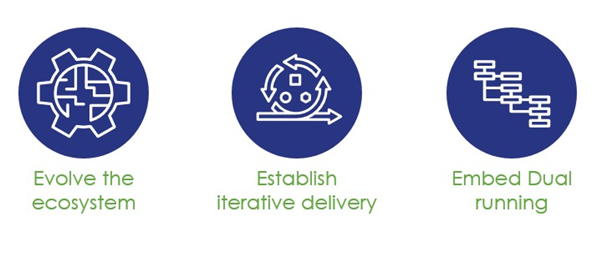Innovating in a complex ecosystem to enhance citizen experience
The other authors that contributed to this blog were:
- Vika Nightingale, Senior User Researcher
- Baz Costello, Product Lead
How can you innovate and go fast in the digital world when the goal posts around policy are not always clearly understood and cross the boundaries of multiple organisations?
Here at Kainos, we took up this challenge to help out one of our public sector clients to rethink their digital footprint so they could improve customer experience.
What we did
Earlier this year Kainos were involved in helping one of our clients to rethink the digital footprint that underpinned their operations. Their aims were to become more agile in the delivery of digital change, whilst ensuring digital services were future proofed, leveraging innovation.
The ecosystem was complex and subject to policy constraints, that were not always clearly understood and crossed the boundaries of multiple organisations.
Our team reviewed previous work to understand the complexity, validate previous findings and identify any potential gaps.
Making sure we understood the vision
Great services live at the intersection of user-centered empathy, analytical and operation rigor, and scalable implementation. Coordinated experiences, the products, business models, services and types of engagement that enable them are increasingly driving demarcation and value. With a clear vision defined, all services can align to a common goal.
We needed to make sure we understood our client's vision and how it could be achieved. We worked with our client to bring together a vision blueprint, which included a vision statement, objectives and relevant success measures. Using this combined view, we identified the enablers the programme needed to deliver to realise the vision. This work helped us understand the complexity of the changes required.
Embedding Strategic Service Design in Complex Ecosystems
Service design is not an isolated 'design thing'; it is a strategic approach that brings together user needs, capabilities, and technology. It is about understanding the user journeys and ensuring that every touchpoint is crafted to meet those, which in turn, defines a long-term product roadmap.
Strategic service design works as the compass that guides the delivery process in any given complex ecosystem. It is an approach that starts with understanding user needs and aligns them using a strategic blueprint that encompasses needs, capabilities, design, and technology. It is a holistic view that ensures all elements are considered and harmonised, ensuring disparate services can come together to provide seamless experiences for citizen's and public sector employees.
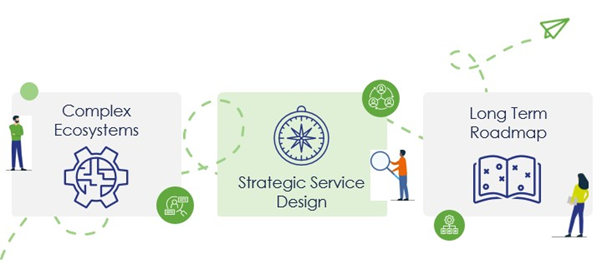
Aligning with a Strategic Blueprint
To start building a comprehensive strategic blueprint, you need to review existing user needs and expand the catalogue even more, refining them and adding new ones. It’s a deep process. We took the time to understand the complexity of our client’s situation, including many existing processes and workflows for different user groups. It was apparent the client had many opportunities across these groups for future improvements, not only through improved technology to the existing ways of working but also a chance to rethink their policies and how those policies translate into the improved flow of information and operational efficiencies.
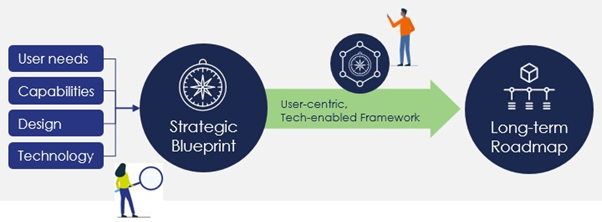
Next, we identified future business capabilities the client needed to invest in to be able to realise their vision. All of this helped us get to a place where we could understand what the future technology landscape could look like, and how the capabilities could be enabled, and which service and capability would be supported by which platform and application.
Understanding Complexity and De-risking Delivery
When things get complicated, you need open lines of communication. This integrated approach helped stakeholders grasp the intricacies of this complex project. It shone a light on potential blind spots, making sure areas which might have been overlooked were brought to the forefront, thereby de-risking future stages of delivery.
Service Design, The Starting Point
Service design is the prologue to the project narrative, not an afterthought. It sets the stage for the client's journey, outlining the right way to approach a project. It is a declaration that success is not just about meeting needs but about anticipating them and showing how different elements come together and depend on each other.
Working in Blended Teams
Collaboration is key to building a multi-disciplinary service view that can be leveraged to plan large transformation programmes. With this in place, we set up blended teams that work together to visualise a new service from different perspectives. The aim is to provide clients with a single source of truth about the change required and how it could be delivered in increments most cost-effectively, providing value early on. These different lenses highlight how specific elements of the change could be grouped and prioritised, to deliver business value iteratively.
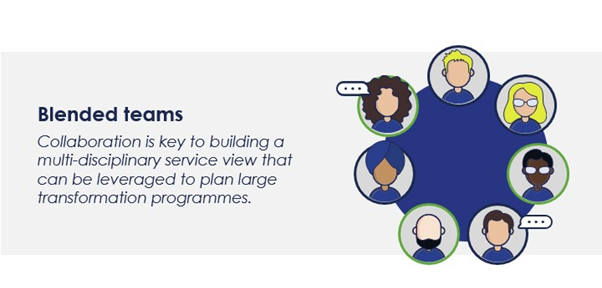
Setting guiding principles early
We needed to agree with the client on a set of principles that would guide the team’s efforts and act as a north star. Here are the three principles we came up with:
Evolve the ecosystem – the as-is solution was a complex application that no longer met the clients' evolving requirements and had become slow to respond to change.
Establish iterative delivery – due to the size and scale, the solution needs to be delivered in small, self-contained releases.
Embed Dual running – there needed to be an acceptance that the current solution couldn’t be ‘turned off’ but had to be removed from operational service.
Creating a Long-Term Backlog
Once we brought the client along a journey to fully understand the service design and its impact on the needs, capabilities and technology, we had to focus on delivery.
We used our Kainos four-step framework playbook, “Managing Product Families.”, which provides clear guidance for how to approach delivery on large, complex, multi-product engagements. It was made for this type of challenge. As part of the first step, we created a high-level, long-term backlog for overall delivery. For this, we relied heavily on the user needs and service blueprint.
Creating Products from a Service Blueprint
As we aimed to create an ecosystem of interconnected tools and products, the service blueprint was essential in helping identify the boundaries for the individual products. Once the user needs, capabilities and functionality were mapped out on the blueprint, it was straightforward to look at how these were grouped and use these grouping to form the basis for the approximate dozen products that would make up the proposed solution.
Defining product teams
Another way the service blueprint proved invaluable emerged when we started to consider the delivery of the proposed solution. As part of the engagement, the client was keen to understand how they could start to form long-lived product teams to own and deliver the service to their users. The blueprint helped us define what we called a ‘delivery framework’. This framework was a way of grouping the products and tools defined above, into areas of the end-to-end service that could be owned by an individual team. We found this approach to team identity and ownership much more productive than say, having multiple teams that just take work from a shared backlog.
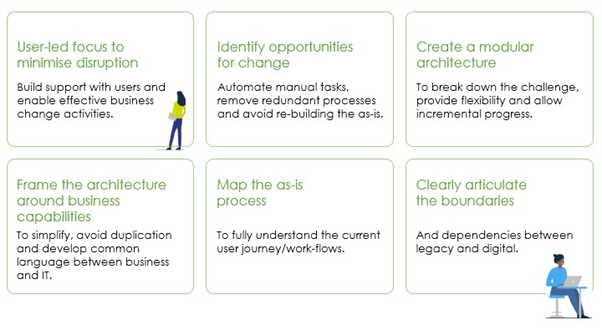
To conclude
A strategic blueprint that informs the product backlog offers numerous benefits to our client and their organisation. It served as a comprehensive guide for future product development, ensuring that all tasks were aligned with the overarching business goals.
By prioritising tasks in the product backlog, the client was able to further effectively manage their resources, focusing on the most critical parts of their complex landscape and prioritising areas that needed further research and experimentation. This meant that we could improve collaboration and communication within the team, as this way of working provided a clear understanding of what needed to be done and its order of importance.
It allowed the client to identify areas which were not considered before and would have been overlooked without this approach being in place. By visualising the complexities and dependencies across existing processes and building a product backlog supporting these dependencies, the client was able to de-risk future delivery and make sure the right building blocks were in place before any technological solutions were implemented. This strategic approach underscored the importance of a user-centric, technology-enabled framework that not only addresses immediate challenges but also positions the organisation for future opportunities better.
At the core of exceptional service delivery lies the intersection of user-centric empathy, analytical precision, operational rigour, and scalable execution. Strategic service design serves as a navigational tool in complex ecosystems, guiding the delivery process with precision. Service design transcends the realm of mere aesthetics; it is a strategic endeavour that synthesises user needs, capabilities, and technological possibilities. It involves a thorough comprehension of user journeys and the meticulous crafting of each touchpoint to fulfil user expectations. This process ultimately informs the development of a long-term product roadmap, setting the stage for sustained innovation and growth.

